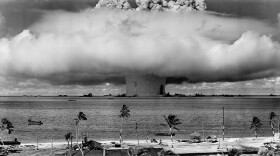In some part of the world, including a site near the Texas-New Mexico border, nuclear waste is kept in rock salt deposits deep underground. It’s long been thought that these geologic formations were some of the safest places to store humankind’s most toxic waste, but new research suggests those places may not be as safe as we thought.
UT-Austin Professor Maša Prodanović, was on the team that published the research, which she says, is ironic because she doesn’t study nuclear storage. They’re in petroleum engineering, and they were studying rock salt deposits because that’s important in the oil business
“That’s the beauty of research,” she says. “Sometimes you just stumble on something that you weren’t looking for."
Rock salt is generally thought to be almost impermeable because of how salt crystals fit together. She holds up shapes, called truncated octahedrons, to represent the interlocking salt crystals. They look kind of like those dice people play dungeons and dragons with.
“It has two different sides, it has smaller sides – six and then eight larger sides, so 14 sides,” Prodanović says.
Normally the crystals fit together with almost no porousness. That’s why canisters of nuclear waste are buried in rock salt, but Prodanović and her team say that under certain high temperatures or certain pressures “they will start melting in corners and that’s where you actually have the pore space that starts to form.”

That means liquids could leak through, including liquids from busted canisters of nuclear waste. That could contaminate nearby aquifers. Pedronovic says the research doesn’t mean salt rock should be abandoned as an option for storing the waste.
Prodanović says the practice gives extra data that needs to be checked on a site, like how much the heat and pressure is bearing down on the rock formation.






